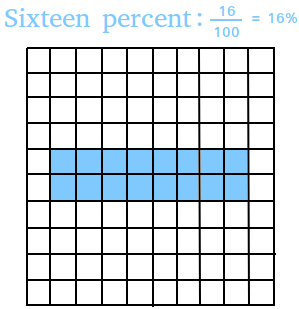Meaning of Percent
A percent is a unique type of rate that expresses a quantity relative to 100, effectively answering "how many per hundred."
Other rates might use various bases, such as "miles per hour" for speed or "cases per population" for health statistics. A percent compares always with 100 and this makes it a special and highly effective tool for comparing and understanding relationships between quantities.
Understanding Percents with an Interactive Grid
The percent symbol (%) means "per hundred." Move the slider below to explore different values!
Try moving the slider to see how different values look visually!
Common Percent Facts
- 50% means half of something
- 25% is a quarter
- 100% is the complete whole
- 0% means none at all
The word "percent" is derived from two parts: "per" and "cent."
- "Per" means "for each" or "by."
- "Cent" is the Latin word for "hundred."
Combined, "percent" literally means "for each hundred," representing a part out of one hundred.
What is 16%?
The figure below has 100 squares. There are 16 blue squares in the figure. Since there are 16 blue squares out one hundred squares we say 16% of the figure have blue squares.

What is the Meaning of Percent in Real Life?
1.
In a country in America, 2% of the people are rich. What is the meaning of the 2%?
It means that for every 100 people, 2 people are rich.
Notice that this will also mean that 4 people are rich out of 200 people.
2.
In a classroom 60% of the students are females. How many males are in that class?
We don't really know how many males are in that class since it is not given.
What we do know, however, is that if 60% of the students are females, then 40% are males.
This means that if that class had 100 students, 60 of them are females and 40 of are males.